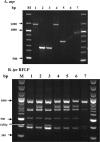Molecular typing of Treponema pallidum: a 5-year surveillance in Shanghai, China
- PMID: 22972832
- PMCID: PMC3486273
- DOI: 10.1128/JCM.01195-12
Molecular typing of Treponema pallidum: a 5-year surveillance in Shanghai, China
Abstract
Previously, a small study showed that 14f was the predominant subtype of Treponema pallidum in Shanghai, China. The result was quite different from the genotype distribution in other areas of China. This study aimed to identify the strain types of Treponema pallidum in samples collected over a 5-year period in Shanghai. From 2007 to 2011, genital swabs were collected from patients with syphilis from the Shanghai Skin Disease Hospital. Positive specimens were typed by the enhanced typing method by adding a tp0548 gene to the existing arp and tpr genotype system. In total, 304 of the 372 enrolled patients yielded fully typeable DNA. Ten arp types (4, 6, 8, 9, 11, 12, 13, 14, 15, and 19), 3 tpr types (a, d, and o), and 5 tp0548 types (a, c, f, g, and i) were identified. In total, 12 subtypes were identified with a combination of the arp and tpr genes. Subtype 14d was found in 270 samples (88.8%). When the combination included the tp0548 gene, the 12 CDC subtypes identified were divided into 14 strain types. The predominant type was 14d/f (88.8%), followed by 15d/f (3.6%), 13d/f (1.3%), and 19d/c (1.3%). Two of the 44 14d/f-infected patients and both of the 19d/c-infected patients who underwent a lumbar puncture were diagnosed with neurosyphilis. This study showed that the predominant type in Shanghai was 14d/f. While this is in keeping with data from other areas in China, it is different from an earlier report showing that 14f is the most common genotype in Shanghai. Further studies are needed to better understand the association between strain types and neurosyphilis.
Figures



Comment in
-
Molecular typing of Treponema pallidum: identification of a new sequence of tp0548 gene in Shandong, China.Sex Transm Dis. 2014 Sep;41(9):551. doi: 10.1097/OLQ.0000000000000155. Sex Transm Dis. 2014. PMID: 25118968 No abstract available.
Similar articles
-
Molecular typing of Treponema pallidum causing early syphilis in China: a cross-sectional study.Sex Transm Dis. 2012 Jan;39(1):42-5. doi: 10.1097/OLQ.0b013e318232697d. Sex Transm Dis. 2012. PMID: 22183845
-
Molecular epidemiological survey of Treponema pallidum in pregnant women in the Zhabei District of Shanghai.J Med Microbiol. 2017 Apr;66(4):391-396. doi: 10.1099/jmm.0.000441. Epub 2017 Apr 6. J Med Microbiol. 2017. PMID: 28126049
-
Molecular diversity of Treponema pallidum subspecies pallidum isolates in Amsterdam, the Netherlands.Sex Transm Infect. 2020 May;96(3):223-226. doi: 10.1136/sextrans-2019-054044. Epub 2019 Aug 5. Sex Transm Infect. 2020. PMID: 31383781 Free PMC article.
-
A Novel tp0548 Gene Type of Treponema pallidum Identified in Nanjing, China: Case Report and Review of Literature.Sex Transm Dis. 2021 May 1;48(5):357-361. doi: 10.1097/OLQ.0000000000001320. Sex Transm Dis. 2021. PMID: 33093286 Review.
-
A comparison of genotyping tool in Treponema pallidum: Review and meta-analysis.Infect Genet Evol. 2020 Mar;78:104049. doi: 10.1016/j.meegid.2019.104049. Epub 2019 Oct 23. Infect Genet Evol. 2020. PMID: 31655225 Review.
Cited by
-
Comparison of CDC and sequence-based molecular typing of syphilis treponemes: tpr and arp loci are variable in multiple samples from the same patient.BMC Microbiol. 2013 Jul 30;13:178. doi: 10.1186/1471-2180-13-178. BMC Microbiol. 2013. PMID: 23898829 Free PMC article.
-
Molecular Typing and Macrolide Resistance Analyses of Treponema pallidum in Heterosexuals and Men Who Have Sex with Men in Japan, 2017.J Clin Microbiol. 2019 Jan 2;57(1):e01167-18. doi: 10.1128/JCM.01167-18. Print 2019 Jan. J Clin Microbiol. 2019. PMID: 30355761 Free PMC article.
-
Molecular Characterization Based on MLST and ECDC Typing Schemes and Antibiotic Resistance Analyses of Treponema pallidum subsp. pallidum in Xiamen, China.Front Cell Infect Microbiol. 2021 Feb 19;10:618747. doi: 10.3389/fcimb.2020.618747. eCollection 2020. Front Cell Infect Microbiol. 2021. PMID: 33680984 Free PMC article.
-
CARE-NS, a research strategy for neurosyphilis.Front Med (Lausanne). 2023 Jan 6;9:1040133. doi: 10.3389/fmed.2022.1040133. eCollection 2022. Front Med (Lausanne). 2023. PMID: 36687428 Free PMC article.
-
MLST typing of Treponema pallidum subsp. pallidum in the Czech Republic during 2004-2017: Clinical isolates belonged to 25 allelic profiles and harbored 8 novel allelic variants.PLoS One. 2019 May 31;14(5):e0217611. doi: 10.1371/journal.pone.0217611. eCollection 2019. PLoS One. 2019. PMID: 31150464 Free PMC article.
References
-
- Chinese Center for Disease Prevention and Control; Center for, STI, and AIDS Prevention and Control 2012. 2011 report on syphilis and gonorrhea epidemic analysis in China. Bull. STI Prev. Control 26:9–19
-
- Cole MJ, Chisholm SA, Palmer HM, Wallace LA, Ison CA. 2009. Molecular epidemiology of syphilis in Scotland. Sex. Transm. Infect. 85:447–451 - PubMed
Publication types
MeSH terms
LinkOut - more resources
Full Text Sources
Medical
Miscellaneous

